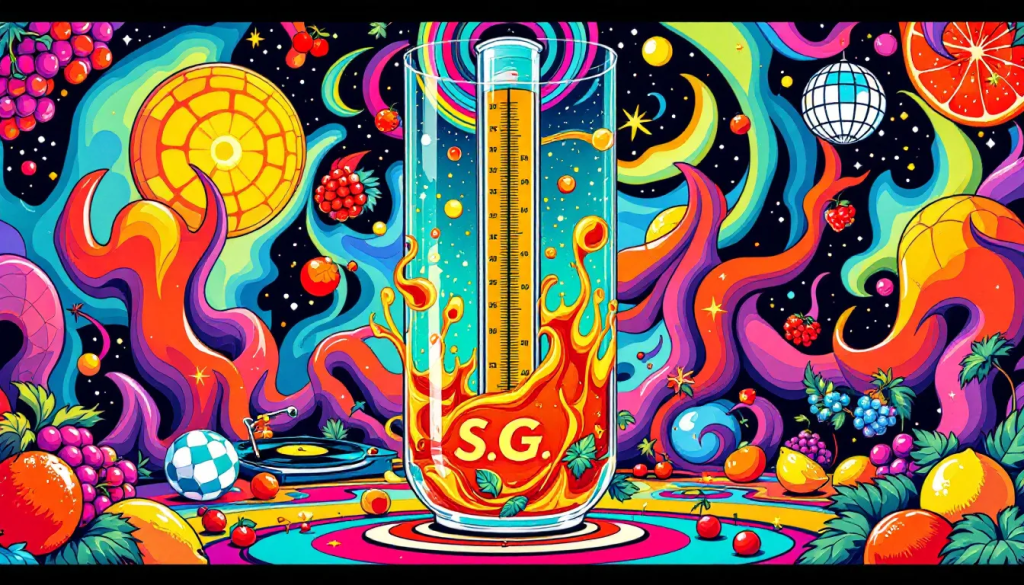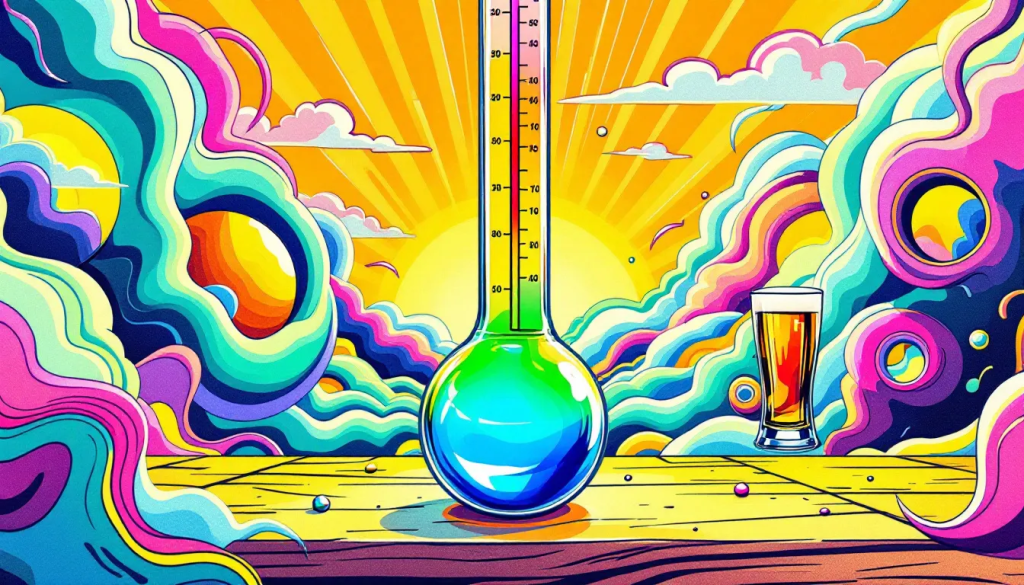Alcohol SG, or specific gravity, measures how dense a liquid is compared to water. In brewing, it’s vital for determining sugar content before and after fermentation, which helps calculate alcohol content. This article will guide you through understanding, measuring, and using SG in your brewing process.
Growlers
- Specific gravity (SG) is essential in brewing for determining sugar concentration and calculating alcohol content through original gravity (OG) and final gravity (FG) readings.
- Accurate SG measurements are critical, influenced by factors like temperature and fermentation byproducts, ensuring consistent beer quality and compliance with desired flavor and alcohol levels.
- Using a hydrometer correctly and performing regular calibrations are necessary for obtaining reliable SG readings and making informed adjustments to the brewing process.
The Basics of Specific Gravity (SG)

Specific gravity (SG) is a measure of the density of a liquid compared to the weight of water. This concept is fundamental in brewing, where it helps determine the concentration of sugars in the wort before and after fermentation. SG is a ratio that indicates how much denser or lighter a liquid is compared to water, which has an SG of 1.000 at 4°C.
In brewing, SG is crucial for monitoring progress. Original gravity (OG) is measured before fermentation, and final gravity (FG) after fermentation. The difference between these readings helps brewers calculate alcohol content and track progress.
Pure Water and SG
Pure water, with an SG of 1.000 at 4°C, serves as the reference for measuring the density of other liquids. A liquid with an SG higher than 1.000 is denser than water, while an SG lower than 1.000 indicates it is less dense.
Temperature can slightly vary the SG of water, but for practical purposes in brewing, it is generally accepted as 1.000. This makes water an ideal reference for comparing the density of wort and beer throughout the brewing process.
Measuring Specific Gravity with a Hydrometer
A hydrometer is an essential tool for measuring specific gravity. It works by floating in the liquid, with the point at which it floats indicating the liquid’s density. Fill a test jar with the liquid sample and gently place the hydrometer into it. The level at which the hydrometer floats will indicate the SG reading.
For accurate hydrometer readings, ensure the liquid is at the hydrometer’s calibrated temperature, typically around 20°C. Deviations require temperature corrections to maintain accuracy.
Take hydrometer readings at eye level and ensure no air bubbles cling to it, as these can skew results. Consistent and accurate readings are vital for tracking the brewing process and making adjustments.
Original Gravity (OG) and Final Gravity (FG)

Original Gravity (OG) is measured before fermentation and indicates the sugar content in the wort, crucial for estimating potential alcohol content. Final Gravity (FG) is measured after fermentation, reflecting the remaining sugar content.
The difference between OG and FG helps calculate the beer’s alcohol content, showing how much sugar the yeast has converted to alcohol. Accurate SG measurements are vital for ensuring the beer meets desired taste and potency standards.
Taking an Original Gravity Reading
Use a wine thief or turkey baster to draw a sample from the fermenter for an original gravity reading, minimizing contamination risk. Avoid placing the hydrometer directly into the wort to prevent contamination.
After taking the sample, pour it into a glass and cover it with plastic wrap. Ferment this sample separately and do not return it to the fermenter to avoid contamination, ensuring accurate and reliable original gravity readings.
Understanding Final Gravity Readings
During fermentation, yeast consumes sugars in the wort, decreasing density and specific gravity. Carbon dioxide production also affects density, making regular FG readings essential for tracking fermented growth. If the gravity readings drop, it indicates that fermentation is progressing.
Monitoring specific gravity throughout fermentation helps track sugar depletion and progress. These readings are crucial for adjusting sugar levels to achieve the desired final alcohol content.
Calculating Alcohol Content from SG Readings

Precise SG measurements are critical for calculating beer’s alcohol content. The difference between original and final gravity readings estimates sugar conversion to alcohol during fermentation, essential for quality control and desired potency.
The relationship between OG, FG, and alcohol content highlights the importance of accurate SG readings. These measurements help brewers add the correct amount of sugar to the wort to achieve desired alcohol levels.
The ABV Formula
The standard formula for calculating alcohol by volume (ABV) is ABV = (OG – FG) * 131.25. This equation is derived by multiplying the difference between the original and final gravity readings by 131.25.
This formula gives brewers a reliable method to estimate the alcohol content of their beer.
Example Calculations
For example, if the original gravity (OG) is 1.045 and the final gravity (FG) is 1.010, applying the ABV formula yields an estimated alcohol by volume (ABV) of 4.59%. This calculation is: ABV = (1.045 – 1.010) * 131.25.
Accurate calculations are vital for ensuring the desired strength of beer. Precise SG readings enable brewers to fine-tune recipes and achieve consistent results across batches.
Factors Affecting SG Readings

Factors like temperature, sugars, unfermentable starches, and minerals in the wort can influence SG readings. Higher sugar content increases wort density, resulting in higher SG readings, while suspended particles can skew readings.
Understanding these factors is crucial for making accurate adjustments during brewing. Regular SG readings help identify deviations and ensure the process stays on track.
Temperature’s Impact on SG
Temperature significantly affects SG readings. Hydrometers are typically calibrated around 20°C (68°F). To ensure accurate readings, cool the wort to this temperature before measurement.
Temperature fluctuations can lead to inaccurate SG readings, requiring corrections. Brewers must account for these variations to avoid misinterpretations that affect the brewing outcome. Regular hydrometer calibration is essential for maintaining accuracy.
Fermentation and Carbon Dioxide
During fermentation, yeast converts sugars to alcohol and produces carbon dioxide as a byproduct. Carbon dioxide can cause temporary SG reading fluctuations, leading to misleading measurements if not properly accounted for.
Understanding carbon dioxide’s role in brewing is essential for accurate SG measurements. Regular monitoring and adjustments help ensure readings reflect actual fermentation progress.
Adjusting Sugar Levels in Brewing

Adjusting sugar levels is crucial for achieving the desired SG and alcohol content. By calculating the difference between current and desired SG, brewers determine how much sugar to add to the wort, influencing both SG and final alcohol content.
Proper sugar adjustments ensure the brewing process yields a product with desired characteristics. Accurate SG readings are essential for effective adjustments.
Calculating Sugar Additions
To calculate sugar additions, follow these steps:
- Subtract the initial specific gravity from the target gravity.
- This difference indicates the required sugar addition to achieve the desired SG.
- Ensure that accurate initial SG readings are crucial for determining the correct sugar quantity.
This calculator helps brewers convert fine-tune methods values recipes and achieve consistent results in their brews.
Monitoring Sugar Content During Fermentation
Regularly measuring specific gravity during fermentation helps track sugar levels and make adjustments. Keeping records of SG readings provides insights into sugar depletion and fermentation progress.
This monitoring is essential for achieving the desired final gravity and ensuring the beer meets the intended alcohol content and flavor profile.
Importance of Accurate SG Measurements
Accurate specific gravity readings are vital for brewing, directly impacting the final product’s quality and consistency. Final gravity readings can indicate yeast fermentation efficiency and provide insights into potential alcohol content and sweetness.
Consistent SG readings help maintain uniform flavor and alcohol levels across batches, ensuring each brew meets equal desired standards.
Ensuring Consistency in Brew Quality
Accurate SG measurements ensure the final product maintains the desired taste, alcohol content, and quality. Factors like temperature fluctuations and carbon dioxide presence can affect SG readings, making it essential to account for these variables.
Common errors, such as incorrect hydrometer usage or not accounting for temperature variations, can lead to inaccurate SG readings and affect brew consistency. Proper techniques and regular calibration of tools are necessary to avoid these errors.
Avoiding Common Measurement Errors
Accurate gravity readings before and after fermentation are crucial for ensuring correct alcohol content. Specific gravity readings can decrease as liquid temperature increases due to reduced density. Brewers must be vigilant about temperature changes, as these can significantly alter SG readings and affect brewing outcomes.
Regular calibration of measuring tools, such as hydrometers, is essential to avoid errors. Ensuring the liquid’s temperature matches the hydrometer’s calibration temperature helps maintain accurate SG measurements. Understanding and mitigating these errors helps brewers achieve consistent and reliable results.
Summary
Specific gravity is a vital metric in the brewing process, providing insights into the density of the wort and its transformation during fermentation. Accurate measurements of original gravity (OG) and final gravity (FG) are essential for calculating alcohol content and ensuring the quality and consistency of the final product. Using tools like hydrometers and maintaining proper techniques for SG readings can significantly enhance the brewing process.
By understanding the factors that affect SG readings, such as temperature and carbon dioxide production, brewers can make necessary adjustments to achieve their desired results. Ensuring precise SG measurements helps maintain the desired taste, alcohol content, and overall quality of the brew. With this knowledge, brewers can elevate their craft and consistently produce high-quality beer that meets their exacting standards.
Frequently Asked Questions
What is specific gravity in brewing?
Specific gravity in brewing is the ratio of the density of the wort to that of water, which helps measure the concentration of sugars before and after fermentation. This measurement is crucial for evaluating the brewing process and final alcohol content.
How do I measure specific gravity accurately?
To measure specific gravity accurately, use a hydrometer in a test jar filled with your liquid sample, ensuring the temperature is at the calibration point, typically around 20°C. This method provides a reliable measurement of specific gravity.
Why are original gravity (OG) and final gravity (FG) important?
Original gravity (OG) and final gravity (FG) are crucial for estimating the potential alcohol content of beer, as the difference between these readings reveals the extent of sugar conversion during fermentation. Understanding these measurements ensures brewers can achieve the desired strength and flavor in their beer.
What is the formula for calculating alcohol by volume (ABV)?
To calculate alcohol by volume (ABV), use the formula ABV = (OG – FG) * 131.25, where OG is the original gravity and FG is the final gravity. This calculation allows brewers to estimate the alcohol content of their beer effectively.
How can temperature affect specific gravity readings?
Temperature directly affects specific gravity readings by altering the liquid’s density. Since hydrometers are calibrated for specific temperatures, deviations require adjustments for accurate measurements.


Leave a Reply